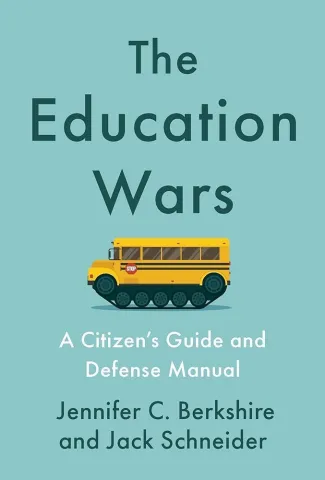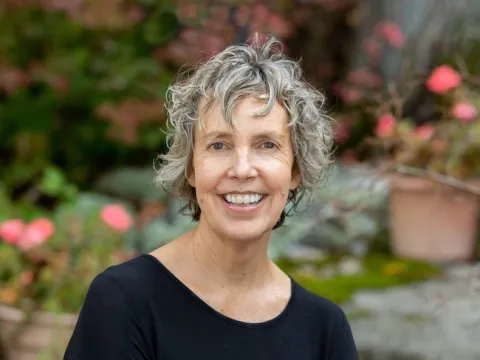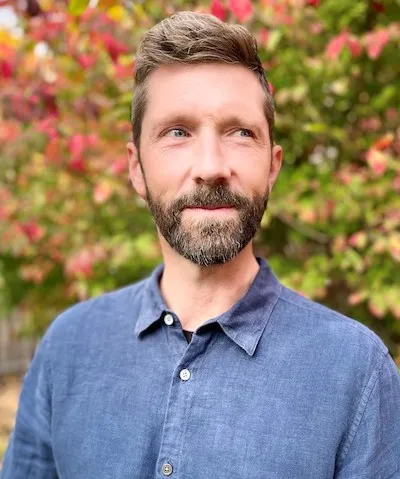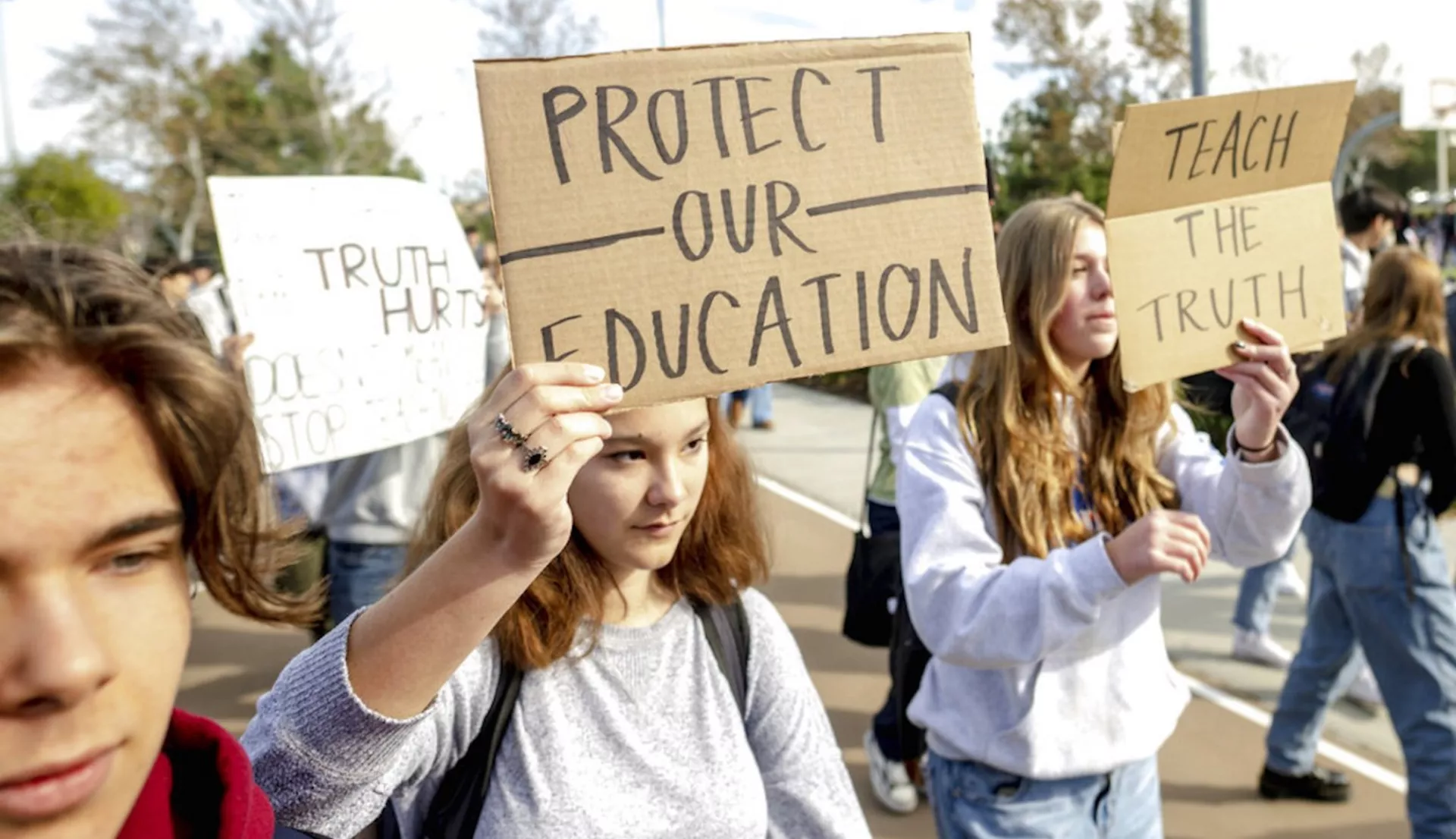
Key Takeaways
- Wealthy, conservative donors are behind groups who seek to ban books and limit how schools address race and gender.
- Culture wars have occurred throughout history. This time, a well-funded group is taking advantage of them to promote the dismantling of public education.
- Vouchers, Moms for Liberty, and book bans are all tools of ultra-wealthy privateers who seek to abolish America's public school system.
In their latest book The Education Wars, journalist Jennifer Berkshire and education scholar Jack Schneider explain the sudden obsession with race and gender in schools and the ascendancy of book bans. It offers analysis of school vouchers and the impact they’ll have on school finances and explores the movement for “parents’ rights,” explaining the rights that students and taxpayers also have.
NEA Today spoke to Berkshire and Schneider about the new book and some of the alarming findings. We also asked about the path forward.
Is public education at risk of being eliminated?
JS: We have always fought over the question of what schooling should look like, who it should serve, and what should be part of the mission. Disagreement and debate are to be expected in a diverse democracy. What’s different today is that the attacks are designed to eliminate public schools as we know them—it’s a longstanding aim among an ideologically committed group that sees public funding as a problem and believes that the free market, not government, should take care of education. They have worked for generations to build power and have seized on this moment of “culture war” to make their play for dismantling public education.
If public schools were to be eliminated, could we get them back?
JB: Here’s a thought exercise. Imagine there is no public schooling and a candidate in 2024 runs on a great new idea: “Let’s provide universal free K-12 for all students and tax ourselves to pay for it!” What was established 150 years ago would seem outrageous today, especially in an environment strongly influenced by wealthy donors who want to do away with public programs. We take for granted the fact that in all of our communities we have tuition-free schools that welcome all of our children—it’s a natural feature of the landscape. The system isn’t perfect, and often disappoints us. But we need to remember that the core features of this system—that it is publicly governed, taxpayer supported, open access, and used to advance the common good—are actually pretty remarkable. Moreover, out public education system has made our country far more equal than it was in the past. If we dismantle public education, it would be difficult if not impossible to bring it back.
Why do polls show that Americans have favorable views of their own schools, but unfavorable views of public education as a whole?

JS: For many Americans, the lived experience with public education is positive. But that’s limited to one or two schools. We don’t really know what’s going on in the 98,000 public schools our kids don’t attend. To learn about all of those other schools, we end up relying on statistics and rhetoric, which is often used in politically opportunistic ways by policy elites.
Prior to the 1980s, the narrative was that public education was doing just fine. But in 1983, when the A Nation at Risk report was released, a new narrative emerged—that public education was in crisis. By now, it’s practically a truism, even with evidence to the contrary. The thing we need to ask ourselves is what do we really know, and how do we know it?
What do we in the U.S. expect our schools to do that other industrialized nations do not?
JB: Sociologist Jessica Calarco has argued, “Other countries have social safety nets. The U.S. has women.” We can make the same argument here – other countries have social safety programs, we have schools. We don’t start at a policy level to make our country equal. We don’t provide universal health care or equitable housing. You’re on your own. Instead, we expect schools to make up for our widening inequality. No other country expects its schools to be the equalizing force that we do.
Think about the child tax credit. After its implementation, childhood poverty fell by a margin we’ve never seen. Then it died without political backing. As a country, we’ve shown a willingness to accept a level of child poverty far above that which exists in any other economically developed country. And that has a huge impact on our schools.
What would expansion of vouchers do to student populations and to communities?
JS: The first thing it will do is exacerbate inequality. We’ll see families with ample resources take vouchers and combine those with the resources they already have. And once their children are taken care of, it will undermine the willingness of these parents to increase their own tax burden to support free and open public education for the rest of the nation’s kids—the majority of them. The families who remain in the system—across all demographic groups, but especially in lower-income communities and communities of color— should expect to see even fewer resources and services in public schools. That means bigger class sizes, fewer paraprofessionals, less access to mental health support, and less time for educators to connect with students.
Another key point is that in a privatized system, people may have choices but they won’t have rights. There will be no legal guarantees that children will be accepted or have their specific needs met. It’s a time machine to a former world—before the rights movements of the twentieth century.
Third, we need to be aware of the long term game plan here. Ultimately, the value of these vouchers will be reduced over time. If a system of vouchers

expands, the cost of educating students in a free market, profit-driven system will need to be reduced. Many families can expect their children to be learning online or warehoused and being taught by some future version of ChatGPT. It’s a pretty bleak future.
Finally, we can expect to become even more fractured as a nation. There’s not a lot that stitches us together these days as coherent democracy. By divorcing ourselves from a shared interest in each other’s young people, we move even closer to a future in which everyone looks out only for themselves. We’ll be one step closer to a society in which the fundamental unit is the individual rather than the community.
If a parent decided to use a voucher for a private school, what would that school look like? What is a typical “voucher school?”
JS: One thing that might surprise people is that the typical voucher school is a religious school, since most private schools are religious. A very small percentage are the ivy walled, elite schools we’d like to imagine.
Does that matter? Yes. In most cases, religious schools have missions that many families would be uncomfortable with, and they would exclude lots of kids. Also, the majority of private schools are operating with fewer resources than public schools. We aren’t talking about Andover and Exeter here. We’re talking more about schools run out of churches or operating out of storefronts in strip malls. With the expansion of vouchers, private schools will seek to capitalize on this opportunity. We can expect them to hire uncertified, non-unionized educators with low pay, who will be expected to teach whatever the school wishes, because the state doesn’t oversee private school curricula.
There’s a lot of wishful thinking among folks who think of this as an exciting opportunity. Yes, some private schools have compelling missions and diverse student bodies and robust financial aid. But that’s not all or even most of them. With more privatization, schools will appear out of nowhere to capitalize on the opportunity. Will they be staffed with amazing educators and incredible curricular materials? No, our best educators are already working as teachers in our public schools.
If a parent is unhappy, can they go back to their public school?
JB: Maybe. But with the expansion of vouchers siphoning resources from your public school, it will be less resourced than it was before.
Who is the largest population of voucher users today?
JB: Currently, vouchers go mostly to pay the tuition of kids who already attended religious schools and never attended public schools. So taxpayers are picking up the tab for private religious tuition for kids who were already in those schools but now have a new subsidy.
Can a family with an LGBTQ+ student attend private school with a voucher? What about students with disabilities?

JS: LGBTQ+ students would be embraced by a Quaker school, but those are a small percentage of the faith-based schools that dominate the private sector. Most LGBTQ+ students would face resistance at a religious private school or, worse, intolerance and exclusion. So vouchers may offer options, but they don’t protect students’ rights. They can deny admission and equal treatment based on their “religious freedom.”
Students with disabilities will face similar obstacles. We recently did a podcast on threats to special education in a voucher system. A mother of a student with disabilities from Tennessee read 20 different rejection letters she got from 20 different schools. In a privatized system, a school can say “no, we don’t have the facilities or the personnel to accommodate your child.” And there will be no incentive to do so. The Individuals with Disabilities Education Act (IDEA), which turns 50 next year, would not apply as it does in our public school system. Again, vouchers provide some options, but no rights, which leaves a large population with no options.
Rather than framing public education as a public good, vouchers reposition it as a form of welfare for those with children. Why is that a dangerous framing?
JB: If we frame it as welfare, it will become easy for us to divest from public education. We won’t see it as something that serves all of us—a system in which we are all stakeholders. Instead, public education will be viewed as a handout for those who can’t afford to pay.
The great irony is that the very same politicians who use the word “welfare” to disparage public education are the ones creating welfare programs for wealthy kids benefiting from vouchers. These vouchers require new monetary sources that the states have to come up with.
Groups like Moms for Liberty say they advocate for "parents’ rights" in schools but seem to advocate only for their “rights” and interests. Is that undemocratic?
JB: Groups like Moms for Liberty define parents’ rights in narrow way and use that to limit and undercut the rights of other parents. Yes, it’s undemocratic in that they are attempting to impose their own narrow view of the world on everybody else.
How is Moms for Liberty funded?
JB: We know that they are a project of the Heritage Foundation, which considers them a signature cause. We also know that the huge summits they hold, which attract right-wing candidates, requires lots of funding that a few moms who came together around a kitchen table wouldn’t have access to. They announced that their group will be spending millions of dollars on campaigns in swing states, which makes it clear that they have wealthy donor support.
Can you explain the concept of Big Us, Small Them?
JS: It’s important to make very clear the fact that the public schools serve the vast majority of American kids and the vast majority of families feel good about the education they are receiving. . We can’t allow supporters of privatization, who represent a small number of zealots, to say there is support among many Americans to do away with public schools. There isn’t.
There is not a big audience of supporters in America seeking to destabilize public education. There is overwhelming support to improve them. Especially if we make clear that the principles underlying our public education system advance the common good. That’s the big us.
It’s also a proven campaign strategy. Candidates allied with Moms for Liberty and 1776 PAC who run on a platform of small angry grievances don’t win. Those who advance the bigger picture do win.
You have a section in your book “Defending Public Schools is not Defending the Status Quo.” Can you explain what that means?
JS: It means that believing in the principles of public education doesn’t mean not working to make public schools better. We can work on making our schools more equal and more equitably funded and less devoted to standardized testing. We can recognize the problems with public education without giving up on the idea altogether.
You point out that teachers can’t defend public education on their own. Who needs to join the effort to protect public schools?
JS: Coalitions of groups are coming together and that’s the best way to stand up to attacks. Civil rights groups, community groups, gay rights groups, pro-democracy groups, and other organizations are coming together with education groups to stand up to voucher programs. We’re seeing a real sense of urgency in these coalitions, like Public School Strong in North Carolina. We’re encouraged by this coalition building.
What more can be done by NEA members?
JB: Start by working with NEA and your local union to get people together to talk about our public schools and how to make them stronger. There's strength in numbers. We always emphasize the importance of coalition building and inclusion. Don’t just contact the same usual suspects and natural allies. Reach out across political differences, across racial and class lines. Start talking about what is happening. If you live in a red state, you’ve probably had voucher legislation introduced. Start talking about that and its threat to communities. If your state hasn’t had a voucher bill introduced yet, begin the conversation about what you’ll do when it comes. And no matter what, all of these conversations should elevate why public education is fundamental to our democracy. That’s what we’re fighting for.
